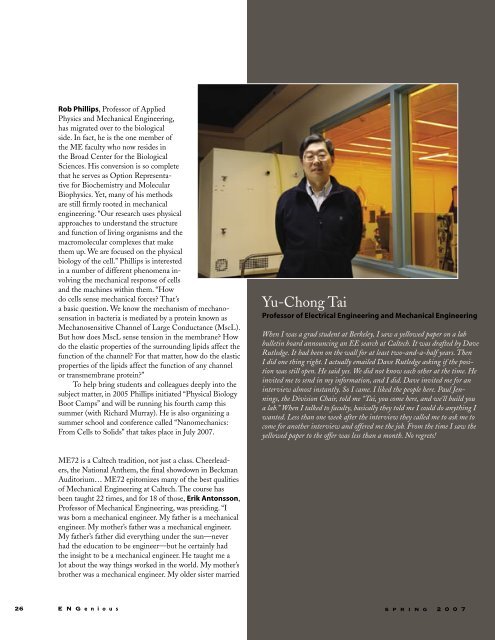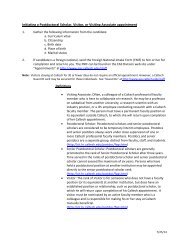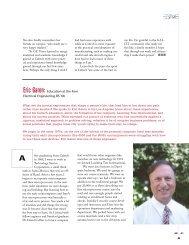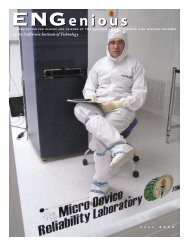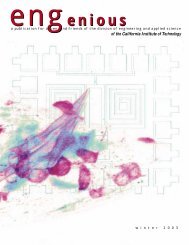Issue No.6 PDF (3 MB) - Division of Engineering and Applied Science
Issue No.6 PDF (3 MB) - Division of Engineering and Applied Science
Issue No.6 PDF (3 MB) - Division of Engineering and Applied Science
You also want an ePaper? Increase the reach of your titles
YUMPU automatically turns print PDFs into web optimized ePapers that Google loves.
Rob Phillips, Pr<strong>of</strong>essor <strong>of</strong> <strong>Applied</strong><br />
Physics <strong>and</strong> Mechanical <strong>Engineering</strong>,<br />
has migrated over to the biological<br />
side. In fact, he is the one member <strong>of</strong><br />
the ME faculty who now resides in<br />
the Broad Center for the Biological<br />
<strong>Science</strong>s. His conversion is so complete<br />
that he serves as Option Representative<br />
for Biochemistry <strong>and</strong> Molecular<br />
Biophysics. Yet, many <strong>of</strong> his methods<br />
are still firmly rooted in mechanical<br />
engineering. “Our research uses physical<br />
approaches to underst<strong>and</strong> the structure<br />
<strong>and</strong> function <strong>of</strong> living organisms <strong>and</strong> the<br />
macromolecular complexes that make<br />
them up. We are focused on the physical<br />
biology <strong>of</strong> the cell.” Phillips is interested<br />
in a number <strong>of</strong> different phenomena involving<br />
the mechanical response <strong>of</strong> cells<br />
<strong>and</strong> the machines within them. “How<br />
do cells sense mechanical forces That’s<br />
a basic question. We know the mechanism <strong>of</strong> mechanosensation<br />
in bacteria is mediated by a protein known as<br />
Mechanosensitive Channel <strong>of</strong> Large Conductance (MscL).<br />
But how does MscL sense tension in the membrane How<br />
do the elastic properties <strong>of</strong> the surrounding lipids affect the<br />
function <strong>of</strong> the channel For that matter, how do the elastic<br />
properties <strong>of</strong> the lipids affect the function <strong>of</strong> any channel<br />
or transmembrane protein”<br />
To help bring students <strong>and</strong> colleagues deeply into the<br />
subject matter, in 2005 Phillips initiated “Physical Biology<br />
Boot Camps” <strong>and</strong> will be running his fourth camp this<br />
summer (with Richard Murray). He is also organizing a<br />
summer school <strong>and</strong> conference called “Nanomechanics:<br />
From Cells to Solids” that takes place in July 2007.<br />
Yu-Chong Tai<br />
Pr<strong>of</strong>essor <strong>of</strong> Electrical <strong>Engineering</strong> <strong>and</strong> Mechanical <strong>Engineering</strong><br />
When I was a grad student at Berkeley, I saw a yellowed paper on a lab<br />
bulletin board announcing an EE search at Caltech. It was drafted by Dave<br />
Rutledge. It had been on the wall for at least two-<strong>and</strong>-a-half years. Then<br />
I did one thing right. I actually emailed Dave Rutledge asking if the position<br />
was still open. He said yes. We did not know each other at the time. He<br />
invited me to send in my information, <strong>and</strong> I did. Dave invited me for an<br />
interview almost instantly. So I came. I liked the people here. Paul Jennings,<br />
the <strong>Division</strong> Chair, told me “Tai, you come here, <strong>and</strong> we’ll build you<br />
a lab.” When I talked to faculty, basically they told me I could do anything I<br />
wanted. Less than one week after the interview they called me to ask me to<br />
come for another interview <strong>and</strong> <strong>of</strong>fered me the job. From the time I saw the<br />
yellowed paper to the <strong>of</strong>fer was less than a month. No regrets!<br />
ME72 is a Caltech tradition, not just a class. Cheerleaders,<br />
the National Anthem, the final showdown in Beckman<br />
Auditorium… ME72 epitomizes many <strong>of</strong> the best qualities<br />
<strong>of</strong> Mechanical <strong>Engineering</strong> at Caltech. The course has<br />
been taught 22 times, <strong>and</strong> for 18 <strong>of</strong> those, Erik Antonsson,<br />
Pr<strong>of</strong>essor <strong>of</strong> Mechanical <strong>Engineering</strong>, was presiding. “I<br />
was born a mechanical engineer. My father is a mechanical<br />
engineer. My mother’s father was a mechanical engineer.<br />
My father’s father did everything under the sun—never<br />
had the education to be engineer—but he certainly had<br />
the insight to be a mechanical engineer. He taught me a<br />
lot about the way things worked in the world. My mother’s<br />
brother was a mechanical engineer. My older sister married<br />
26 E N G e n i o u s<br />
s p r i n g 2 0 0 7


